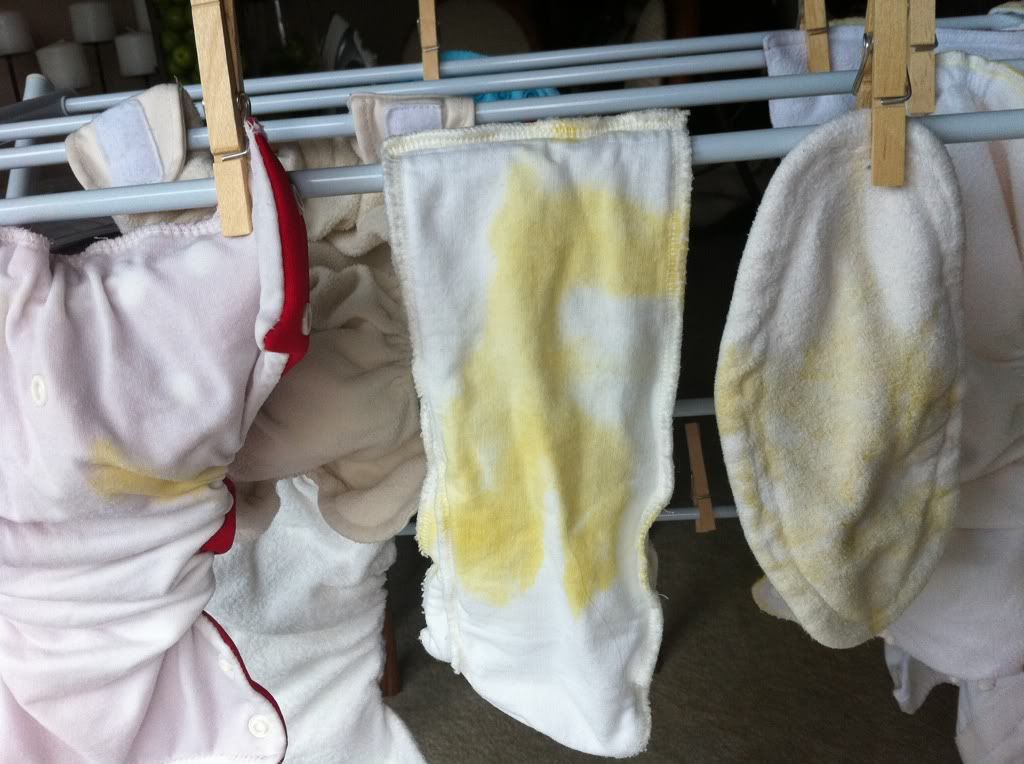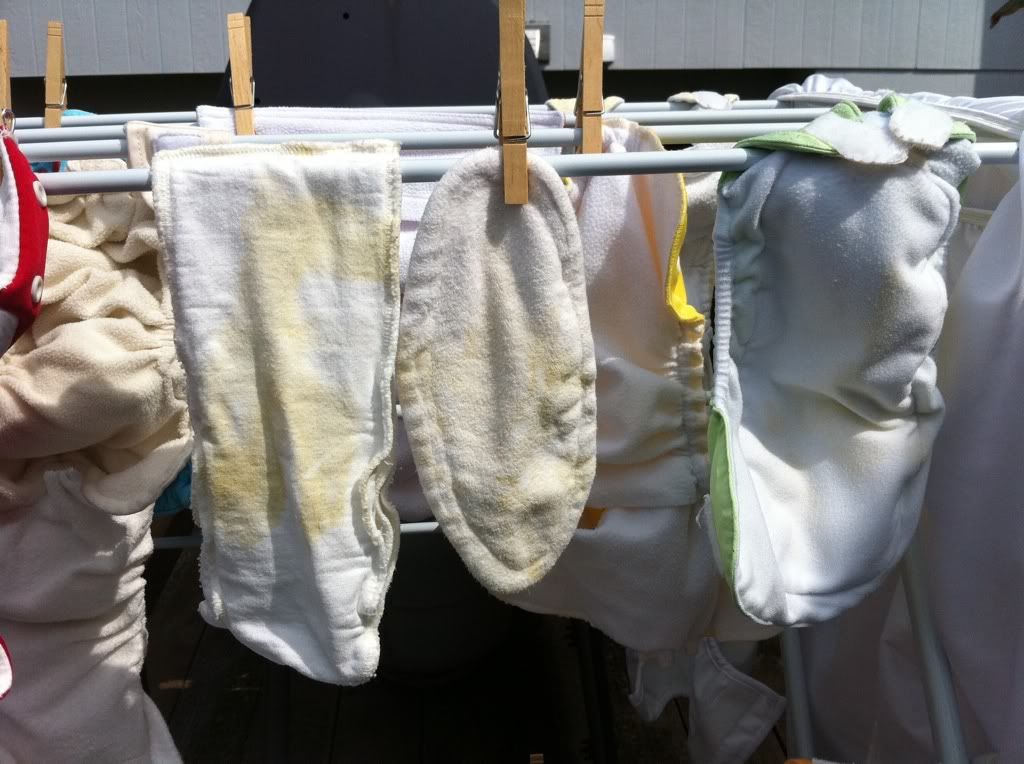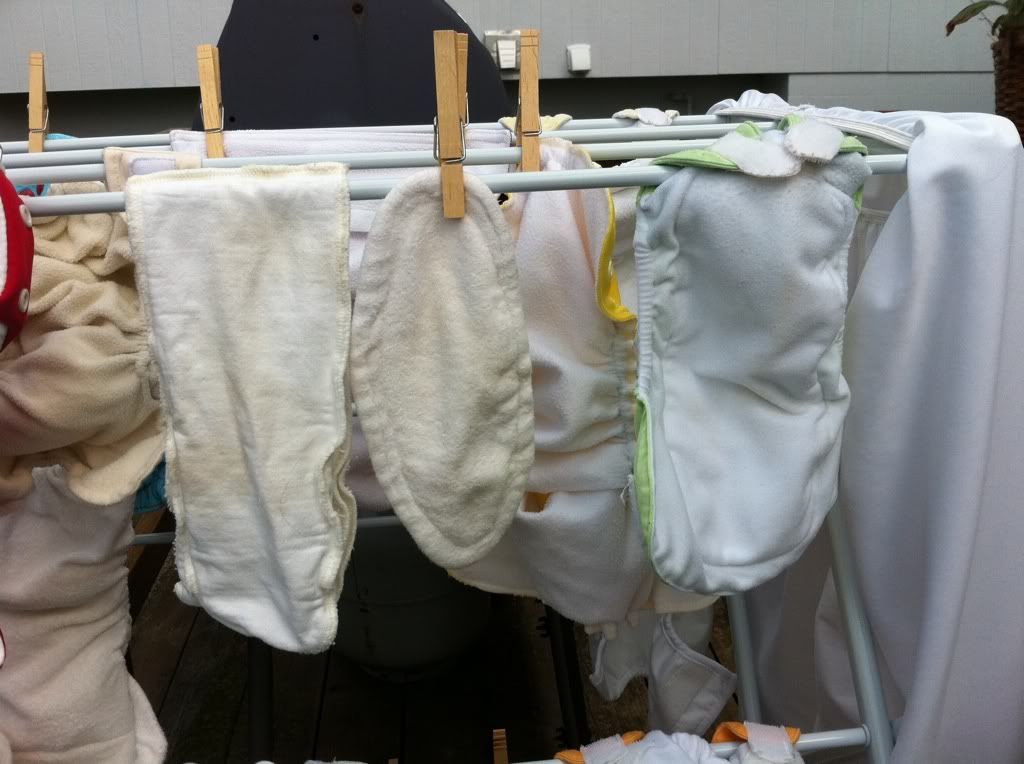Our first "new" cloth diapering mama is Adriane, mother to a beautiful five-month-old named Darian. She recently started cloth diapering and has this to share (you can read the original at her blog, Half a Bite):
_______________________________________
Fluffy bums
So, I use cloth diapers on Darian's bum. I love it now, but I made a LOT of mistakes in the beginning which could have steered me back to disposables had I not spent a significant amount of money on the things.
The Prep
Let's start at the beginning. Long before I was pregnant, I came across a thread on The Nest about cloth diapers. I was intrigued. So I looked it up, read about the virtues (Save the environment! Save money! No rash! No poopsplosions! And they're cute!), and decided that when the time came, I'd give it a shot.
Victor wasn't convinced, but since I'd be the one staying home, changing most diapers, and doing laundry, he agreed.
Once I was pregnant, I tried to read up, but was overwhelmed without actual samples to look at. At a friend's suggestion, I visited a local cloth diaper shop. The woman in the shop gave us a riveting demonstration of the different types, and we went ahead and bought the whole starter kit of 30 brand new diapers plus all the accessories.
From what I had read earlier, I thought that all-in-ones would take too long to dry, and pockets would be too much effort to stuff. So I got some Totsbots Bamboozle bamboo fitteds with covers, and some Grovia all-in-2s with snap in cotton soakers, all "one size" which would fit from about 9-35 lbs. (I'd explain it all but others have done a better job, so you can read more on The Awesome Cloth Diaper Blog.)
Victor and I had agreed to stick with disposables for the newborn stage, and then transition to cloth as parenthood became more manageable. I figured that the baby would start fitting in the one-size diapers within about a month. I was excited.
Starting out
Darian was born at 7 lbs 11 oz. The newborn-sized disposables lasted about two weeks before he started outgrowing them and we decided to try out a Grovia. He was probably around 9 lbs by then.
I snapped it to the smallest setting, put it on him and it looked HUGE. A couple of hours later, I changed the diaper and was disappointed at how wet it felt. I thought there was no way they'd last through a night.
At one point, he had an explosive poop which scared the cat, but more importantly, leaked all over the place.
We had slightly better luck with the Bamboozles, but they were also way too bulky.
Not only that, but Darian was a very gassy newborn, and the bulky cloth diapers made it difficult for us to deal with that. Thin disposables, being much thinner and more flexible, made it easier for us to pump his legs to help with the gas.
Finally, I did find the laundry a little overwhelming. Both the Bamboozles and Grovias seemed to take forever to dry.
I started to think this was a mistake, and an expensive one.
Growing into them
So, we kept using mostly disposables through the first three months. I kept using the cloth every now and then, but by no means full time.
I also took back some of the Grovias, and exchanged them for Fuzzibunz.
Fortunately, I loved the Fuzzibunz - they fit Darian well, they are fairly trim, and the microfibre inserts dry quickly. And stuffing pockets wasn't as big a deal as I thought!
When Darian turned three months old, Victor went back to work. Left to my own devices, I started using cloth full-time. I braved night-time cloth diapering with the Bamboozles and lo and behold, they worked! I joined cloth diaper buy/sell/trade communities and sold off some of the Bamboozles in order to buy some more used Fuzzibunz (saving enough Bamboozles just for night-time use).
Also, Darian started growing into the diapers, and outgrowing his gas issues, so that they bulkiness was no longer an issue. I started noticing that the cloth was way better at containing poops (it wasn't a big issue when Darian was a newborn because poops were regular and small... but as he got bigger, they got bigger and more forceful). And I got into a groove with the laundry.
So now, I'm loving it. I almost never deal with diaper leaks, and if I do, they're very tiny. I even use cloth when we go out - even though the diapers are bulkier to carry, it's so much easier to do that than change clothes while we're out. Today was our first garbage day without a single diaper in the trash.
If I could start again...
- I'd start with trying a few different types (natural and synthetic fibres, pockets, AIOs, AI2s and fitteds) rather than deciding that one or two would work for us
- I'd try to start with some cheaper brands or buy used
- I'd consider buying newborn fluff, or at least realize that one-size wouldn't work for at least a couple of months
- I'd join a community where I could chat with other cloth diapering mamas and learn a lot more
So, that's my story. I realize that a lot of these mistakes have been discussed in blogs and whatnot (including the one I linked above), but hey... live and learn.
The Prep
Let's start at the beginning. Long before I was pregnant, I came across a thread on The Nest about cloth diapers. I was intrigued. So I looked it up, read about the virtues (Save the environment! Save money! No rash! No poopsplosions! And they're cute!), and decided that when the time came, I'd give it a shot.
Victor wasn't convinced, but since I'd be the one staying home, changing most diapers, and doing laundry, he agreed.
Once I was pregnant, I tried to read up, but was overwhelmed without actual samples to look at. At a friend's suggestion, I visited a local cloth diaper shop. The woman in the shop gave us a riveting demonstration of the different types, and we went ahead and bought the whole starter kit of 30 brand new diapers plus all the accessories.
From what I had read earlier, I thought that all-in-ones would take too long to dry, and pockets would be too much effort to stuff. So I got some Totsbots Bamboozle bamboo fitteds with covers, and some Grovia all-in-2s with snap in cotton soakers, all "one size" which would fit from about 9-35 lbs. (I'd explain it all but others have done a better job, so you can read more on The Awesome Cloth Diaper Blog.)
Victor and I had agreed to stick with disposables for the newborn stage, and then transition to cloth as parenthood became more manageable. I figured that the baby would start fitting in the one-size diapers within about a month. I was excited.
Starting out
Darian was born at 7 lbs 11 oz. The newborn-sized disposables lasted about two weeks before he started outgrowing them and we decided to try out a Grovia. He was probably around 9 lbs by then.
I snapped it to the smallest setting, put it on him and it looked HUGE. A couple of hours later, I changed the diaper and was disappointed at how wet it felt. I thought there was no way they'd last through a night.
 |
| See? Huge, right? |
At one point, he had an explosive poop which scared the cat, but more importantly, leaked all over the place.
We had slightly better luck with the Bamboozles, but they were also way too bulky.
Not only that, but Darian was a very gassy newborn, and the bulky cloth diapers made it difficult for us to deal with that. Thin disposables, being much thinner and more flexible, made it easier for us to pump his legs to help with the gas.
Finally, I did find the laundry a little overwhelming. Both the Bamboozles and Grovias seemed to take forever to dry.
I started to think this was a mistake, and an expensive one.
Growing into them
So, we kept using mostly disposables through the first three months. I kept using the cloth every now and then, but by no means full time.
I also took back some of the Grovias, and exchanged them for Fuzzibunz.
Fortunately, I loved the Fuzzibunz - they fit Darian well, they are fairly trim, and the microfibre inserts dry quickly. And stuffing pockets wasn't as big a deal as I thought!
 |
| Happy bum, happy baby! |
When Darian turned three months old, Victor went back to work. Left to my own devices, I started using cloth full-time. I braved night-time cloth diapering with the Bamboozles and lo and behold, they worked! I joined cloth diaper buy/sell/trade communities and sold off some of the Bamboozles in order to buy some more used Fuzzibunz (saving enough Bamboozles just for night-time use).
Also, Darian started growing into the diapers, and outgrowing his gas issues, so that they bulkiness was no longer an issue. I started noticing that the cloth was way better at containing poops (it wasn't a big issue when Darian was a newborn because poops were regular and small... but as he got bigger, they got bigger and more forceful). And I got into a groove with the laundry.
So now, I'm loving it. I almost never deal with diaper leaks, and if I do, they're very tiny. I even use cloth when we go out - even though the diapers are bulkier to carry, it's so much easier to do that than change clothes while we're out. Today was our first garbage day without a single diaper in the trash.
 |
| And they're delicious! |
If I could start again...
- I'd start with trying a few different types (natural and synthetic fibres, pockets, AIOs, AI2s and fitteds) rather than deciding that one or two would work for us
- I'd try to start with some cheaper brands or buy used
- I'd consider buying newborn fluff, or at least realize that one-size wouldn't work for at least a couple of months
- I'd join a community where I could chat with other cloth diapering mamas and learn a lot more
So, that's my story. I realize that a lot of these mistakes have been discussed in blogs and whatnot (including the one I linked above), but hey... live and learn.




















































